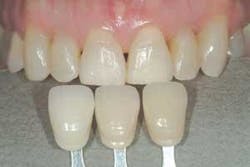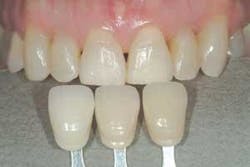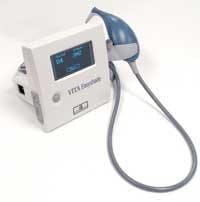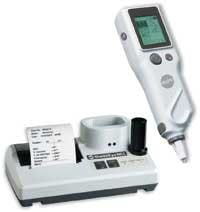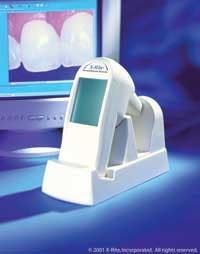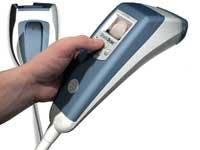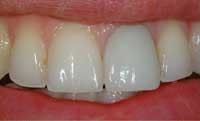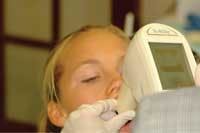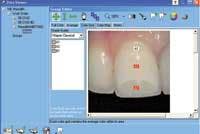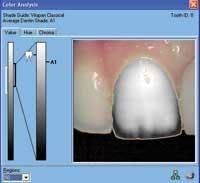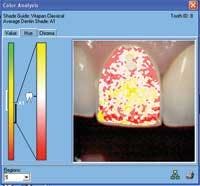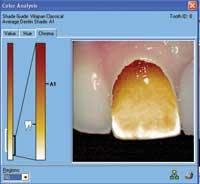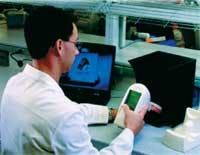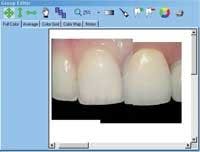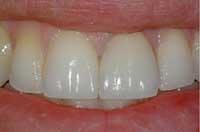Shade-matching technologies:
Put away your rabbit’s foot. Today, luck is no longer required to match tooth colors and shades.
Effective communication between the clinical team and laboratory technician is the cornerstone of a successful long-term partnership. The accurate communication of detailed color is critical to the successful delivery of esthetically acceptable single-unit as well as unilateral anterior restorations. The subjectivity involved in assessing color has been one of the most difficult remaining barriers to accurate communication between the dentist and technician. At long last, new technology dramatically enhances the predictability of achieving an accurately matched restoration - direct or indirect.
The importance of color
Historically, successful shade matching has been a combination of art, science and, unfortunately, luck. Using the science of dentistry to match the artistry of natural dentition, the dental profession has continued to advance the field of esthetic restorative dentistry. We as technicians now have materials and technologies available that make undetectable restorations possible on a consistent basis - if we receive accurate color and shading information. Determination of the proper shade required for a restoration is highly subjective and heavily dependent upon illumination, environment, and the receiver’s eye. The stakes are high for balancing realistic goals against the patient’s esthetic expectations, and mismatches can be stressful for all parties.
Shade matching encompasses several variables as well as a delicate balance between a patient’s personal expectations and the realistic goals of the clinician. As a general rule, laboratories admit to a 6 percent remake rate as an acceptable cost of doing business. At least half of these remakes (3 percent) are color-related and occur as a result of either a misinterpretation of the provided data, or inaccurate data.
Using the science of dental materials to match the art of natural tooth color poses significant challenges. The human eye is recognized as one of the best color devices in the world - a true marvel of bioengineering; however, it does have its limitations. Critical elements affecting color perception include the following controlling variables -
☛ The type and quantity of light source
☛ The sample, including textures and layers
☛ The receiver (i.e., eye) or processor
Limitations that can make accurate color assessment problematic include -
▲ Retinal fatigue
▲ Background effects
▲ Lighting (metamerism)
▲ Color blindness - (1:13 U.S. males; 1:300 U.S. females)
▲ Age of the receiver
Technological challenges
Beyond the physical realities, recording and effectively communicating tooth color and its infinite nuances presents an incredible challenge. The use of 35mm slides has long been recognized as the benchmark for accurate dentist/laboratory color communication, but even this highly regarded method has numerous limitations -
❯ The type and saturation of the light source
❯ Ambient colors in the shading environment
❯ Wrong shade guide used in the operatory, requiring cross-matching in the laboratory
❯ The inability of the technician to adequately confirm a match between the restoration and the natural dentition prior to delivery.
Shade-guide limitations
Current shade guides in dentistry have been accepted with recognized limitations. The aging of these guides combined with potential “darkening” of the tabs due to cold sterilization create havoc if undiscovered. We also know that these guides represent only about 30 percent of the color range of natural dentition. With the addition of today’s advanced colorimeter technology, qualitative and quantitative reliability more than doubles to approximately 70 percent of true color. The popularity explosion of nonvital tooth bleaching has introduced yet another significant limitation in shade matching.
In addition, none of the currently available laboratory restorative systems are available in more than two shade systems (Bioform, Vita Classic, Vita 3-D, Ivoclar, etc.), with many available in only one. Quite often this creates the need for “cross-matching” which requires the technologist to reformulate the material shades to match the particular dentition - an extremely subjective process!
Applications - direct and indirect
A great deal of emphasis has been placed on the indirect restorative benefits of these recent shade-communication technologies, but there has been only minimal discussion regarding direct restorative applications which are valuable in tracking the progress of dentist-directed, at-home bleaching - possibly preventing the patient from going to “extremes” with tooth whitening. They also serve as an excellent tool for identifying the color components needed to build a direct composite veneer restoration by capturing the contra-lateral tooth information to serve as a guide for an accurate color- and translucency-matched restoration.
The majority of products involve color control as a critical part of the manufacturing process. For example, magazines, automobiles, clothing, and paint products use advanced technology to quantify color for consistency and accuracy. In the continuing quest for optimal dental esthetics, new systems and devices must be considered.
A review of available systems
The dental marketplace has been deluged in recent years with a number of new devices engineered to aid us in color communication. To help in understanding these systems, we will divide them into two categories.
➊ Dot capture systems - These systems capture a reading of an area approximately the size of a large curing light tip. Therefore, in order to capture the whole tooth, multiple readings are required to communicate the cervical, middle, and incisal areas. These simpler systems are less expensive and easier to operate, but provide less-detailed information.
The available systems in this category are:
Vita Easyshade - Retail price is $3,495. Sold through a dealer network, it is a self-contained system; uses a spectrophotometer.
For more information, call (800) 828-3839 or visit www .vident.com (Figure 1).
Shofu ShadeEye NCC - Retail price is $5,495. Sold through a dealer network, it is a chromameter, and a computer is required for the lab. For more information, call (800) 82SHOFU (827-4638) or visit www.shofu.com (Figure 2).
➋ Whole-tooth capture systems - These systems provide a reading of the whole tooth to be matched. This provides the operator with far more data including maps of the value, hue, and chroma of the tooth. The technician also has the ability to choose the appropriate shade system (Vita Classic, Vita 3-D, Chromascop, etc.) for the restorative material to be used. Finally, the technician has the opportunity to capture an image of the restoration and compare it with the image of the dentition being matched. Arguably, this could be the most significant enhancement in the crucial quality assurance process since the introduction of the Vita shade guide. These more complex systems are, as expected, more expensive, but provide significantly more detailed data.
The available systems in this category are:
X-Rite ShadeVision - Retail price is $6,000. Sold through a dealer network (Sullivan-Schein), it is colorimeter-based and a computer is required by the clinician and laboratory. For more information, call (800) 372-4346 or visit www.xrite .com (Figure 3).
Cynovad ShadeScan - Retail price is $8,995. Purchased directly from the manufacturer, it is colorimeter-based and a computer is required by the lab. For more information, call (866) CYNOVAD (296-6823) or visit www.cynovad.com (Figure 4).
Clinical example 1:
Re-treatment of esthetically displeasing oxide-discolored porcelain-fused-to-metal restoration on tooth No. 9 (Figure 5).
The ShadeVision system from X-Rite was used to capture the shade data (Figure 6). (The choice of the ShadeVision system illustrates my bias based on my overall personal experience.)
Average shade readings for the Vitapan Classical Shade Guide were displayed on a computer monitor (Figure 7).
A Captek non-oxidizing coping veneered with d-Sign porcelain from Ivoclar Vivadent was fabricated, providing dramatically improved esthetic results. The Captek substrate provides the finest esthetic possibilities when ceramo-metal restorations are indicated (Figure 13). Note the “Virtual Try In” by the technician in the laboratory confirming the accuracy of the match prior to returning the completed restoration to the office for delivery (Figures 11 and 12).
Clinical dentistry and photography (Figures 5 through 15) courtesy of Dr. Robert Lowe, Nash Institute, Charlotte, N.C.
Clinical example 2:
Re-treatment of a previously placed, discolored composite restoration on maxillary central incisor No. 9 (Figure 16).
The ShadeVision system was used to provide a map for the specific placement of shaded and translucent materials by capturing an image of the contra-lateral tooth.
Conclusion:
The general public’s increased interest in esthetic dentistry is driving our profession to deliver higher levels of patient satisfaction. The incorporation of advanced shade-data instruments combined with the continuous improvement of restorative materials are making this not only possible, but also predictable.
New digital shade-taking devices are providing dentists and technicians with an equally powerful communication tool and quality-control device. This technology ultimately leads to an increase in productivity and improved customer service for clinicians as well as laboratories that are willing and able to master the application. In today’s world of rapidly evolving technology, these devices serve as powerful pre-emptive problem-solving tools attracting a great deal of interest from manufacturers, clinicians, and laboratories alike. Digital shade-matching technology is sure to become a standard component in the contemporary dental office and laboratory.
Clinical dentistry and photography (Figures 16 through 24) courtesy of Dr. Frank Milnar, St. Paul, Minn. Opening graphic (teeth and shade tabs) courtesy of Dr. Steve Ratcliff, director of academic affairs, The Pankey Institute.
David Avery, AAS, CDT, is the director of professional services for Drake Dental Laboratory in Charlotte, N.C. Avery teaches undergraduate and postgraduate dental students at the UNC, MUSC, and VCU dental schools, and is a visiting lecturer at various hospitals and universities. He is a published author in numerous professional journals, and currently serves as program chairman for the prestigious “Forum for Dental Esthetics” based in Charlotte, N.C. Reach him at (800) 476-2771, or e-mail [email protected].
